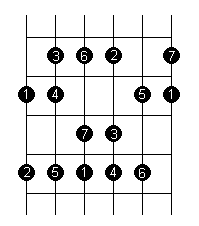
This tutorial was inspired by a question that I was recently asked via the AllExperts website.
This tutorial covers a basic idea for an exercise, which once you've got to grips with it, it should be easy enough for you to as a starting point and adapt it into variations of your own.
The exercies here are based around scale 'boxes', and they should help you to hone several aspects of your technique:
For the first exercise, it's probably easiest to start by explaining in a sentence or two just what you'll be playing, and then showing some tablature. This exercise uses a basic scale 'box' for the major scale (check out Meet the Major Scale for more information on this if you need it) and you'll be moving upwards through the scale, playing pattens of three sequential notes (1-2-3, 2-3-4, 3-4-5, and so on).
Have a look at the following notation which describes the exercise through - you should be able to spot the pattern without any problems. Pay particluar attention to the timing involved here: strict triplets in 4/4 time (a bit more about this in a moment, in case you're not too familiar with counting time).
This exercise is written in 4/4 time - that means that there are 4 beats to each bar, counted as '1' - '2' - '3' - '4'. Imagine just playing the first note in each triplet group and letting it ring for a whole beat, and that's what you'd get. However, this exercise splits each beat into three notes of equal duration - a bar lasts just as long, but you have to play three notes in the space of a single beat. This can be counted as '1 and a' - '2 and a' '3 and a' - '4 and a'. For more about rhythm patterns and how they're counted, check out the series of tutorials on the subject.
Play the exercise through, using all the notes in the scale box. As with all picking exercises, start at a tempo that is comfortable for you, and build the speed up as you become more proficient. Don't just dive in and try to play it as fast as you possibly can, otherwise it will be uneven. Use a metronome to help you with the timing if you want.
If you're using this an exercise in learning the notes in a scale, then as you play each note say (or think) both the note name and its number from within the scale (e.g. "C 1 - D 2 - E 3, D 2 - E 3 - F 4..."). Obviously, this limit how quickly you can actually play the exercise, but in this case, speed is not the ultimate goal.
There are obviously several different ways that you can adapt this basic exercise. I'll give you a few suggestions here, and you can take these ideas and either use them verbatim, or develop your own variations
The most obvious variation, really. Instead of moving upwards through the scale, start on the highest notes, and move down in patterns of 1-7-6, 7-6-5, 6-5-4 and so on.
Don't just run through this exercise in the key of C major - move the scale 'box' around the neck and play in different keys. I'd suggest that you follow the Circle of Fifths from C, moving clockwise, rather than simply moving up or down a semitone after each repetition. This is especially useful if you're using this as an exercise for learning note names in each key.
Instead of just using the major scale, use other scales such as the natural minor, harmonic minor and modes (this exercise doesn't work quite so well with pentatonics, though). If you're using this exercise to learn note names, when you say a notes number, remember to use the numbering that is applicable to the scale formula (e.g. "b3" instead of "3" in a minor key, and so on).
If you're feeling adventurous, you could try playing four notes per beat instead of three. In this case, you would be playing patterns of 1-2-3-4, 2-3-4-5, 3-4-5-6, etc. You could extend this idea to playing 5 notes, or even more, per beat if you wanted to take that idea still further.
How useful did you find this tutorial?